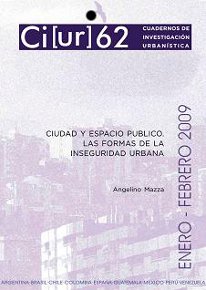
Ciudad y espacio público. Las formas de la inseguridad urbana
Texto completo:
PDFResumen
La dimensión de la seguridad, de hecho, se coloca en una encrucijada en que convergen, por una parte, los procesos de adquisición del capital social (donde el protagonista es la sociedad civil) y, por otra, las intervenciones de “law enforcement” (donde las protagonistas son las instituciones con distintos niveles y competencias). Este enfoque intenta reducir la distancia entre dos orientaciones: la resultante de la acción encaminada a garantizar la obediencia a las leyes y a contrastar el crimen “law enforcement-crime control-security” y la constituida por la acción de prevención promovida por los mecanismos de cohesión internos de la comunidad “safety-capital social” y por la oferta de servicios públicos, evidenciando la necesaria complementariedad entre las dos vías de acción. Las políticas de seguridad en Italia, así como en otros países europeos, muestran claramente signos de ambivalencia, emblema del tránsito del Estado del welfare al del neoliberalismo. En síntesis, podemos sostener que algunas ciudades no han expresado aún una política de gobierno local del bien público de la seguridad. Parece, así, desaparecer la posibilidad de un modelo único de seguridad, a aplicar prescindiendo del contexto, mientras que se diseñan políticas de gobernanza de la seguridad que tengan en cuenta una pluralidad de condiciones históricas, políticas, sociales y culturales, coordinándose todas ellas para obtener una seguridad realizable y multidisciplinaria. Aunque el urbanismo y la planificación resulten incapaces de resolver estos problemas pueden, en todo caso, contribuir a no agravarlos. El uso diferenciado de los espacios públicos es un dato relevante que es preciso considerar, así en el diseño como en la integración sociocultural y no sólo en términos de percepción de la seguridad.
Abstract:
The topic of the safety in the cities has been consolidated by the background of an increasing relevancy of the urban government crisis and the difficulties of the urban development thought to face a social deman increasingly differentiated and demanding. The city, really, represents, the natural way where the fear for the criminality is spreaded and where teir effects are deployed; under this challenge, the city is changing deeply in the forms, in the organizational modalities, in the individual and collective behaviors. Departing from the centralisation acquired by the notion of " urban safety " inside the policies of management and transformation of the territory, the text overcoat has tried to investigate the different theoretical and methodological approaches relative to these topics.
The dimension of the safety, in fact, is placed in a crossroads on which there converge, on one hand, the processes of acquisition of the share capital (where the protagonist is the civil society) and, for other one, the interventions of law enforcement (where the protagonists are the institutions with different levels and competitions). This approach tries to reduce the distance between two orientations: the resultant one the action directed to guaranteeing the obedience to the laws and to confirming the crime (law enforcement-crime control - security) and the constituted one for the action of prevention promoted by the internal mechanisms of cohesion of the community (safety-share capital social) and for the offer of public services, demonstrating the necessary complementarity between both routes of action. The safety policies in Italy, as well as in other European countries, shows clearly signs of ambivalence, emblem of the traffic of the State of the welfare to that of the neoliberalism. In synthesis, we can hold that some cities have not expressed yet politics of local government of the common good of the safety. It seems to eliminate, this way, the possibility of the only model of safety, to applying doing without the context, whereas policies are designed of governance of the safety that they bear in mind a plurality of historical, political, social and cultural conditions, all of them being coordinated to obtain a realizable and multidisciplinary safety. The urbanism and the planning seem to turn out to be unable to solve these problems they can not help to aggravate them, in any case. The separated use from the public spaces is a relevant information that is precise to consider, this way in the design as in the sociocultural integration and not only in terms of perception of the safety.
Palabras clave
Enlaces refback
- No hay ningún enlace refback.

Este obra está bajo una licencia de Creative Commons Reconocimiento-NoComercial-SinObraDerivada 4.0 Internacional.
Editado en Madrid por Departamento de Urbanística y Ordenación del Territorio (ETSAM), UPM.








